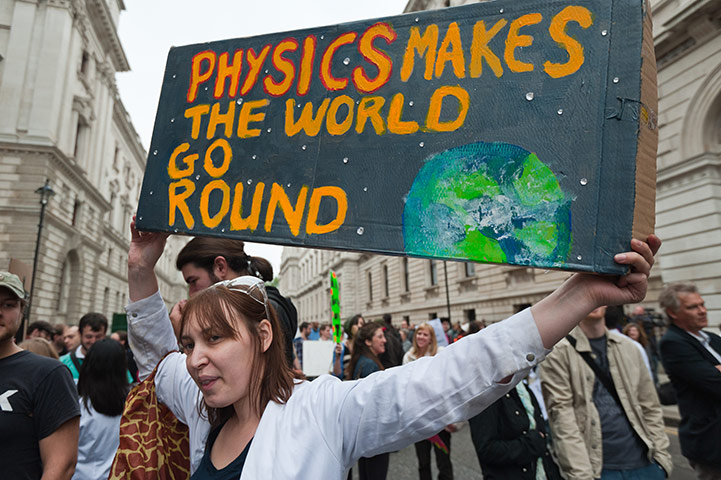Editorial
One decade into the 21st century, science (and physics in particular) has started to congeal into a very different model than was norm for most of the 20th century. We live in world in which anti-science sentiment seems to be on the increase, both from religious folk who turn to fundamentalism as a bulwark against modernism, and also from a large number of educated and secular people who seem to feel that science simply has not delivered on its promises. This is not just the "what have you done for me lately crowd" (although there are plenty of them), but "post modernists" who are skeptical of rationalism and the scientific method as world views. These are the folks who embrace the concept of multiple equivalent routes to truth, to which as a good empiricist my response is "prove it."
I wonder if the rise of scientific research and technological sophistication in Chinese, Indian, and other non-European societies may be affecting this point of view. I would like to see a serious study of philosophical and religious viewpoints among Chinese and Indian scientists. I have certainly heard very well-educated researchers claim to believe in some rather seriously flawed superstitions from areas outside of their area of expertise. These were nations that were not directly heirs of the European Enlightenment, and instead had very long-standing and entrenched philosophical systems (Confucianism, so-called Vedic Science, the Kerala School of mathematics) which mixed rational and non-rational elements. Of course, the move from rationalism is just as strong among Western academics, and you have to look no farther than the Huffington Post or Oprah to see people like Deepak Chopra or oz Garcia or Andrew Wyland peddling a mixture of science, pseudoscience and spiritualism.
But the irony is that this a time of remarkable scientific achievement. The by-word of early 21st century science is "interdisciplinary", and many of the most notable achievements of recent years, like those in nonlinear dynamics and metamaterials, cross traditional disciplinary lines. That is not to say disciplinary research is dead, and certainly in my own field of particle physics it has been a banner couple of years.
Particle Physics
The biggest news in particle physics in 2010 was, of course, the turn-on of the Large Hadron Collider. The LHC had an initial short run, at lower energies, in late 2009, but starting March and continuing with remarkable efficiency until the scheduled Christmas shutdown, the collider operated at a center of mass energy of 7 TeV, half the target energy of 14 TeV. A short late heavy ion run in November demonstrated the LHC's ability to accelerate nuclei, and produced some interesting new results. I was at CERN just before Thanksgiving when my experiment, ATLAS, announced the measurement of "centrality-dependent dijet asymmetry" - no. I didn't know what that meant at first either, but it turns out to be an important signature of the formation of quark-gluon plasma. We were also able to produce first results for the summer conferences, also a remarkable achievement since usually there is a year or so between first data and finished analyses. We already have several papers published. No Higgs boson...yet.
 |
| My graduate student, Ram Dhullipudi (far right in tan jacket) in the ATLAS control room during first 7 TeV LHC collisions |
The same week the ATLAS was finalizing the dijet asymmatery results from the heavy ion run, two other experiments at CERN, ALPHA and ASACUSA, announced the first sample of trapped antihydrogen atoms. Antihydrogen, fromed from an antiproton and an antielectron, was first produced in 1995, but it has taken until now to develop techniques to trap these antimatters atoms. The trapping times are only on the order of 0.1 seconds, but once the discovery is made, its just engineering after that.
The Tevatron is still running, and like a well-loved old car that just seems to keep running, the old collider continues to produce some interesting results. My experiment, D0, published on the most controversial results in particle physics this year - like-sign dimuon anomaly. This observation of an excessive asymmetry
A≡(N++-N--)/(N+++N--) between pairs of postive and negative like-sign pair of muons may signal a new and significant source of CP-violation, which leads to the excess of matter over antimatter in our universe. The result was summarized in an excellent "Editor's Viewpoint" editorial in Physics. I will let the editor, Roy Briere, summarize:"If this intriguing hint of new physics holds up to scrutiny and is confirmed elsewhere, it will join other significant milestones of high-energy physics. Even if it fades away, it can still live on as part of a testament to the proper workings of empirical science. Indeed, the advent of modern scientific methodology, which forms the root of all our work, is the greatest milestone of all."
A few years ago, the U.S. particle physics community came up with a pithy way of classifying the experiments we do. The devised three categories: The Energy Frontier, The Intensity Frontier, and The Cosmic Frontier. The Tevatron and now the LHC represent the Energy Frontier. The Intensity Frontier would be future neutrino experiments, for example from the Project X at Fermilab after the Tevatron shuts down. The Cosmic Frontier is the realm of searches for Dark Matter and Dark Energy. Just like last year, there were some intriguing hints from Dark Matter searches, particularly results from the Fermi experiment (named after the person, not the lab - it used to be called GLAST) and DAMA. In March 2010 Fermi announced that active galactic nuclei are not responsible for most gamma-ray background radiation. This leads to new models that have to include Dark Matter interactions. The DAMA experiment in the Gran Sasso mine continues to accumulate evidence for Dark Matter in the Milky Way galactic halo.
As I am typing this article, I just received an email update from Scientific American that the IceCube experiment has been completed at the South Pole. With 86 strings of detectors reaching down 2.5 kilometers i the Antarctic ice, this is the largest neutrino observatory ever constructed. An extension of the old AMNADA project, IceCube will look for neutrinos from cosmic sources such as supernovae and gamma-ray bursters.
Lastly, the Eyjafjallajokull volcano erupted in Iceland. What does this have to do with particle physics? Well, it happned the week of one of the largest conferences, the 18th International Workshop on Deep Inelastic Scaterring, held in Firenza. Several attendees were stranded or unable to get to the conference. Personally I made it as far as Barcelona, and ended up giving two talks over the phone from my hotel room. Barcelona is a nice city to stuck in, though...
 |
| Students demonstrators in London |
Elsewhere in Physics & Astronomy
The search for exoplanets continues to be a great adventure. Astronomers discovered a potentially habitable planet of similar size to Earth in orbit around a nearby star, shown in this artist's impression. Gliese 581g is in its solar system's 'Goldilocks zone' – not too hot and not too cold for liquid water to exist. Personally, if this discovery pans out - some groups are skeptical of the claim - I prefer the other name the discoverers gave the planet: Zamira's World.
 |
| Artist's impression of Gliese 581g |
Other Science News
Biologist and entrepreneur Craig Venter and his team revealed that they had created the world's first 'synthetic life form', paving the way for designer organisms that are built rather than evolved. They synthesized the genome of an existing bacterium from scratch and used it to 'reprogram' another bacterial cell
We now know that, around 100,000 years ago, there were four distinct hominds lived simultaneously on this Earth of ours. Besides our Homo Sapiens ancestors, there were the Neanderthals, the Hobbits of Flores Island, and a newly discovered species in what is now Russia called H. Denisova. These Denisvoans may have interbred with H. Sapiens, according to genetic evidence announced late this year.
But maybe the biggest news in the long run came in late November, when researchers in Berlin announced that they had cured a man of AIDS using stem cell therapy.
Notable Physics and Astronomy Deaths
Georges Charpak - inventor of the wire chamber. An experimental particle physicist and detector developer, he turned to medical imaging later in life. A Polish-French Jew, he fought in the resistance and was imprisoned in the Dachau concentration camp. He was awarded the 1992 Nobel Prize in Physics
Nicola Cabibbo - should have won the 2008 Nobel Prize, with laureates Kobayashi and Maskawa. I mean, we call it the CKM matrix, for cripes sake! An outstanding Italian physicist who also fought for rationalism in Italian education.
I had the opportunity to see both Charpak and Cabibbo at CERN. One of the real joys of working in an environment like CERN.
Benoit Mandlebrot - another Polish-French Jew, who emigrated to the United States. And another giant of 20th century science who should have won Nobel. Mandelbrot is best known, of course, for his work in maps, fractals, and nonlinear systems.
Andrew Lange - CalTech astrophysicist who worked on balloon-borne measurements of the cosmic microwave background.
Geoffrey Burbridge - astronomer and developer of the "quasi-steady state" model of the universe.
Ulrich Baur - was a friend of mine. An exceptional theorist who a professor at SUNY-Buffalo, I best remember Uli as someone who was willing to discuss physics with anyone, including a dumb graduate student. He will be missed by a lot of folks int he field.
Brian Marsden - director of the Central Bureau for Astronomical Telegrams, which was founded by the International Astronomical Union in 1920.
Allan Sandage - made the first accurate measurements of the Hubble constant and the age of the universe.
Martin Gardner - the intellectual's friend. Mathematician and science writer.
Jack Horkheimer - popularizer of astronomy, the Star Hustler.
The Worst Thing to Happen to Science in 2010
The worst thing to happen to science is the continuing campaign of lies and mis-characterizations surrounding global climate change. The Right Wing in the United States (with allies globally) have indoctrinated their followers into rejecting any suggestion that climate change is happening, or if it is happening that it has any human-made causes. This is bad for all of science of course, since the methodology of our colleagues in climate studies are not so different than those employed by the rest of us. Attacks on the integrity and professionalism of one group of scientists is an attack on us all. Unfortunately the scientific community has been very timid in answering these attacks, and that can only spell trouble later on. Not mention, of course, that the whole business causes us to lose time in possibly combating climate change, while we may have the ability to affect outcomes over the next century,

